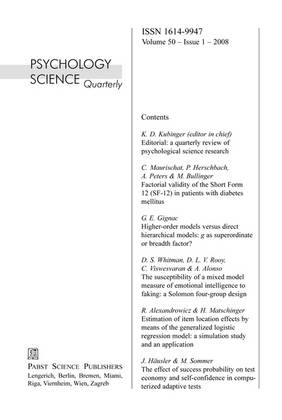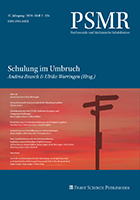Contents, Volume 50, 2008, Issue 1
KLAUS D. KUBINGER (editor in chief)
Editorial: a quarterly review of psychological science research![]() PDF of the full article
PDF of the full article
CARSTEN MAURISCHAT, PETER HERSCHBACH, ACHIM PETERS & MONIKA BULLINGER
Factorial validity of the Short Form 12 (SF-12) in patients with diabetes mellitus
Abstract | ![]() PDF of the full article
PDF of the full article
GILLES E. GIGNAC
Higher-order models versus direct hierarchical models: g as superordinate or breadth factor?
Abstract | ![]() PDF of the full article
PDF of the full article
DANIEL S. WHITMAN, DAVID L. VAN ROOY, CHOCKALINGAM VISWESVARAN & ALEXANDER ALONSO
The susceptibility of a mixed model measure of emotional intelligence to faking: a Solomon four-group design
Abstract | ![]() PDF of the full article
PDF of the full article
RAINER ALEXANDROWICZ & HERBERT MATSCHINGER
Estimation of item location effects by means of the generalized logistic regression model: a simulation study and an application
Abstract | ![]() PDF of the full article
PDF of the full article
JOACHIM HÄUSLER & MARKUS SOMMER
The effect of success probability on test economy and self-confidence in computerized adaptive tests
Abstract | ![]() PDF of the full article
PDF of the full article
Factorial validity of the Short Form 12 (SF-12) in patients with diabetes mellitus
CARSTEN MAURISCHAT, PETER HERSCHBACH, ACHIM PETERS & MONIKA BULLINGER
Abstract
Measuring quality of life is considered as an important outcome criterion in clinical studies. Generic instruments as the Short Form 12 Health Survey offer the possibility to compare outcomes among different indications. Therefore a test of the factorial (structural) validity of the method in each indication is necessary. This study is based upon SF-12 data from 343 patients with diabetes mellitus, which were pooled together from two rehabilitation research projects. The psychometric properties of the measure were analyzed, and the questionnaires structure was tested using confirmatory structural equation modeling. In a second step age and gender specific analyses were undertaken.
The questionnaires psychometric properties prove to be comparable to international results. The structural analyses support a model that specifies covariations of errors between two items of same wording ("accomplished less"). SF-12 physical and mental (latent) components are highly associated. Therefore construct validity must be criticized. Moreover both physical and mental health seem not to be independent in patients view, since items response is influenced by same wording more than subjective health reception. SF-12 summary scores should not be seen and misinterpreted as independently.
Key words: quality of life, SF-12, Diabetes
Carsten Maurischat, Ph. D.
Leibniz-Institute for Science Education
Olshausenstr. 62
D-24098 Kiel
Phone: +49 431 880 3097
Fax: +49 431 880 5242
E-Mail: c.maurischat@gmx.de
Higher-order models versus direct hierarchical models: g as superordinate or breadth factor?
GILLES E. GIGNAC
Abstract
Intelligence research appears to have overwhelmingly endorsed a superordinate (higher-order model) conceptualization of g, in comparison to the relatively less well-known breadth conceptualization of g, as represented by the direct hierarchical model. In this paper, several similarities and distinctions between the indirect and direct hierarchical models are delineated. Based on the re-analysis of five correlation matrices, it was demonstrated via CFA that the conventional conception of g as a higher-order superordinate factor was likely not as plausible as a first-order breadth factor. The results are discussed in light of theoretical advantages of conceptualizing g as a first-order factor. Further, because the associations between group-factors and g are constrained to zero within a direct hierarchical model, previous observations of isomorphic associations between a lower-order group factor and g are questioned.
Key words: confirmatory factor analysis, higher-order models, hierarchical models, general intelligence
Gilles E. Gignac
School of Psychology
University of Western Australia
35 Stirling Highway
Crawley, WA, 6009
Australia
E-Mail: gilles.gignac@genos.com.au
The susceptibility of a mixed model measure of emotional intelligence to faking: a Solomon four-group design
DANIEL S. WHITMAN, DAVID L. VAN ROOY, CHOCKALINGAM VISWESVARAN & ALEXANDER ALONSO
Abstract
This study used a Solomon four-group design to investigate the fakability of a widely used measure of emotional intelligence (EI). Administration instructions (faking/honest-response) and testing effects (pre-test/no pre-test) were the two conditions (i.e., 2 x 2) examined; two different Solomon four-group designs - one for fake-good instructional treatments and one for fake-bad instructional treatments - were assessed. Participants (n = 300) were randomly assigned to one of the six conditions and results indicate a significant pre-testing effect for fake-bad but not fake-good instructions. However, the interaction of testing and treatment was only significant for fake-good but not fake-bad. As expected, within-subjects designs resulted in higher distortion than between-subjects designs for both fake-good (d-value of 1.08 compared to 0.10) and fake-bad instructions (4.07 vs. 3.56, respectively). Participants were able to fake-bad more than fake-good, irrespective of the design used and scaling effects. Implications for EI assessments are discussed.
Key words: emotional intelligence, test faking, pre-testing effects, assessment, selection
Daniel S. Whitman
DM-266, Department of Psychology
University Park Campus
Florida International University
Miami, FL, 33199
USA
Phone: 404-213-1066
E-Mail: dwhitman@yahoo.com
Estimation of item location effects by means of the generalized logistic regression model: a simulation study and an application
RAINER ALEXANDROWICZ & HERBERT MATSCHINGER
Abstract
The present paper deals with the application of the generalized logistic regression model to the estimation of item location effects. A Monte Carlo study demonstrates that item difficulties and item location effects show excellent parameter recovery when distributional assumptions of the marginal maximum likelihood method are not met. A practical application to a reasoning test revealed the existence of item location effects and an effect of total test taking time. This model allows for the flexible utilization to a wide range of problems and thus provides a powerful tool for item analysis.
Key words: Item location effect, position effect, Generalized Logistic Regression Model, Generalized Linear Mixed Model, Linear Logistic Test Model
Univ.Ass. Mag. Dr. Rainer Alexandrowicz
University of Klagenfurt
Institute of Psychology
Department of Applied Psychology and Methods Research
Universitätsstraße 65-67
A-9020 Klagenfurt
Austria
Phone: +43 (0) 463 2700 1627
E-Mail: rainer.alexandrowicz@uni-klu.ac.at
The effect of success probability on test economy and self-confidence in computerized adaptive tests
JOACHIM HÄUSLER & MARKUS SOMMER
Abstract
Recent research on the psychological effects of different design decisions in computerized adaptive tests indicates that the maximum-information item selection rule fails to optimize respondents test-taking motivation. While several recent studies have investigated psychological reactions to computerized adaptive tests using a consistently higher base success rate, little research has so far been conducted on the psychometric (primarily test reliability and bias) and psychological effects (e.g. test-taking motivation, self-confidence) of using mixtures of highly informative (p = .50) and easier items (p = .80) in the item selection process. The present paper thus compares these modifications to item selection with a classical maximum-information algorithm. In a simulation study the effect of the different item selection algorithms on measurement precision and bias in the person parameter estimates is evaluated. To do so, the item pool of the Lexical Knowledge Test, measuring crystallized intelligence and self-confidence, is used. The study indicated that modifications using base success probabilities over p = .70 lead to reduced measurement accuracy and - more seriously - a bias in the person parameter estimates for higher ability respondents. However, this was not the case for the motivator item algorithm, occasionally administering easier items as well. The second study (n = 191) thus compared the unmodified maximum-information algorithm with two motivator item algorithms, which differed with regard to the percentage of motivator items presented. The results indicate that respondents yield higher self-confidence estimates under the motivator item conditions. Furthermore, the three conditions did not differ from each other with regard to the total test duration. It can be concluded that a small number of easier motivator items is sufficient to preserve test-taking motivation throughout the test without a loss of test economy.
Key words: adaptive testing, test economy, success probability, test taking motivation
Joachim Häusler
Hyrtlstraße 45
A-2340 Mödling
Austria
Phone: +43 2236 4231529
E-Mail: haeusler@schuhfried.at























